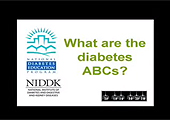NIDDK director keynotes MLK observance
By Eddy Ball
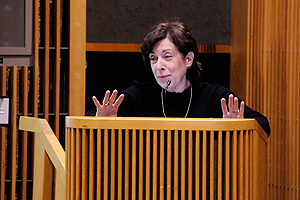
Birnbaum listed a few of Rodgers’ many accomplishments during his 11 years as director and deputy director of NIDDK. “I just have to say, that was great,” she exclaimed at the end of his talk. “You just have to come back, so that more people can have the opportunity to talk with you one-on-one.” (Photo courtesy of Steve McCaw)
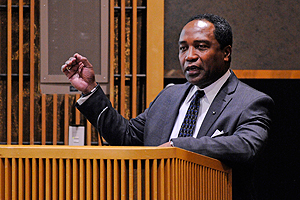
“There’s a direct correlation between the mission areas of NIDDK and NIEHS and those diseases that disproportionately affect people of color. This is really the mission that moves me at a scientific level, but also at a moral level,” Rodgers told the audience. “Serving others is the ultimate mission of NIDDK and it certainly is the ultimate mission of NIEHS — a mission of science and medicine at its very best.” (Photo courtesy of Steve McCaw)
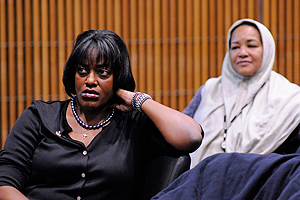
BIG leaders Veronica Robinson, left, and Annette Rice both applauded Rodgers’ work to address health disparities. “Because of the weather, he’s going to fly out early, but we will have him back, hopefully later this year,” Robinson told the audience following Rodgers’ presentation. (Photo courtesy of Steve McCaw)
NIEHS observed the birthday of Martin Luther King Jr. Jan. 25 with a presentation on obesity, kidney, and metabolic disease research by Griffin Rodgers, M.D., (http://www2.niddk.nih.gov/AboutNIDDK/Director/default.htm) director of the National Institute of Diabetes and Digestive and Kidney Diseases (NIDDK). Rodgers’ talk was sponsored by the NIEHS Office of the Director, Raleigh Durham Area Chapter of Blacks In Government (BIG), and NIEHS Diversity Council.
Linked Video
Watch a short video featuring Rodgers’ recommendations for people with diabetes (05:29)
(Launches in new window)
Download Media Player: Flashhttp://get.adobe.com/flashplayer/
In her introduction of Rodgers, NIEHS/NTP Director Linda Birnbaum, Ph.D., described the close partnership the two institutes continue to enjoy, with their common interest in equality, primary prevention, and the environment. “We share a lot of interest in environmental exposures and the increase in obesity and type 2 diabetes,” she said.
At several points in his talk, Rodgers also reinforced the ways the missions of NIEHS and NIDDK dovetail, underscoring his institute’s growing awareness of the role of gene-environment interactions in health and disease. “I feel a real kinship, because the missions of NIDDK and NIEHS are really one in the same – preventing illness, improving people’s well-being, and saving lives. And, much of the work that we [NIDDK] are trying to achieve ties very closely into the work being done here at NIEHS.”
Rodgers connected his institute’s research mission to the larger social issues of equality in terms of health disparities and environmental justice, invoking King’s spirit in the quest to prevent and better treat a range of diseases that disproportionately affect people of color. “One of our society’s greatest injustices is the fact that African-Americans, Latinos, and other people of color are more likely to get sick and die younger than the population as a whole — and, not coincidentally, [because of] the fact that members of these racial and ethnic groups are more likely to be exposed to toxic environments, because of the neighborhoods where they live.”
Obesity fuels multiple medical problems
Like several other conditions, obesity and the diseases it fuels are chronic, common, costly, and consequential. These diseases, which range from diabetes and cardiovascular disease to end-stage renal disease and several types of cancer, have increased in terms of incidence and financial burden over the past few decades. According to Rodgers, this trend suggests that, along with genetic predisposition, environmental triggers, including diet, lifestyle, and other environmental exposures, may play an important role. African-Americans, Native Americans, Latinos, and other people of color experience rates of some of these diseases that are two to four times those of whites.
In the past twenty years alone, Rodgers said, obesity rates in the U.S. have tripled, growing from 10 percent or less in 1990 to more than 30 percent in 2010. Annual costs for treating obesity and related diseases range from conservative estimates of $27 billion for chronic kidney diseases to $174 billion for type 2 diabetes. Increasingly, younger people are developing these diseases, with as many as 17 percent of children now considered obese, and children in their early teens developing what used to be considered adult-onset type 2 diabetes.
NIDDK has supported a number of clinical trials to compare intervention outcomes and cost effectiveness in reducing the risk of diabetes progression, and it has translated findings into alternative ways of preventing and treating disease. After findings emerged, indicating that lifestyle changes in diet and exercise, combined with counseling, were more effective than medication, NIDDK funded an experiment, involving a group counseling and exercise program at YMCAs, as a model for what might become a community-based, cost-effective national network to help combat diabetes and prediabetes.
As Rodgers returned to King at the end of his presentation, he quoted from what is known as the civil rights leader’s drum major sermon. “’Life’s most persistent and urgent question is, what are you doing for others?’” King had challenged his audience, observing that everyone, no matter how few his or her gifts and talents, can reach out to achieve greatness by serving others. “’Let us seek to be the best servants.’”
For more information, visit the NIDDK website at http://www2.niddk.nih.gov/. (http://www2.niddk.nih.gov/)

NIEHS Deputy Scientific Director William Schrader, Ph.D., was among the audience members who took advantage of the unusually generous 20 minutes set aside for questions and answers. (Photo courtesy of Steve McCaw)
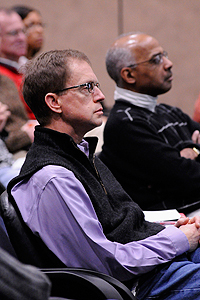
Rodgers drew an audience that included representatives from groups throughout the Institute, including Deputy Associate Director of Management Chris Long, left, and NTP pathologist Robert Sills, D.V.M., Ph.D. (Photo courtesy of Steve McCaw)
Translating research into education and outreach
Like NIEHS, with its Partnerships for Environmental Public Health, Superfund Research, and Workers’ Education and Training programs, NIDDK also translates research into educational and public awareness materials, which it posts prominently on its home page (http://www2.niddk.nih.gov/) Materials are reader friendly and available in as many as 20 different languages, with messages geared to patients, families, healthcare providers, and even school personnel who need to accommodate children with handicaps related to their conditions.
“One group that we’re extremely interested in getting this message to are women who have had a history of gestational diabetes,” Rodgers said. Some 5 to 7 percent of pregnancies experience this type of diabetes, with long-term risk among the mothers and their newborn children for developing diabetes.
“This material is not only scientifically valid,” Rodgers said of NIDDK educational publications, “but [also] has been socially marketed to be sure that the message we’re trying to get out is socially and contextually appropriate.”
Rodgers also communicates by radio throughout the nation, with regular “Healthy Moments” segments. He said that one of NIDDK’s greatest challenges is overcoming the widespread fatalistic assumption that obesity-related diseases are inevitable. Today, more people than just a few years ago consider diabetes to be an important health problem that should be addressed as early as possible. Still, nearly two-thirds of those polled still don’t recognize its significance or understand how great a role diet and lifestyle, throughout an individual’s lifespan, play in the development and progression of disease.
"NIEHS welcomes NINDS director ..." - previous story ![]()
![]() next story - "Tickner encourages alternative solutions ..."
next story - "Tickner encourages alternative solutions ..."
February 2013 Cover Page



